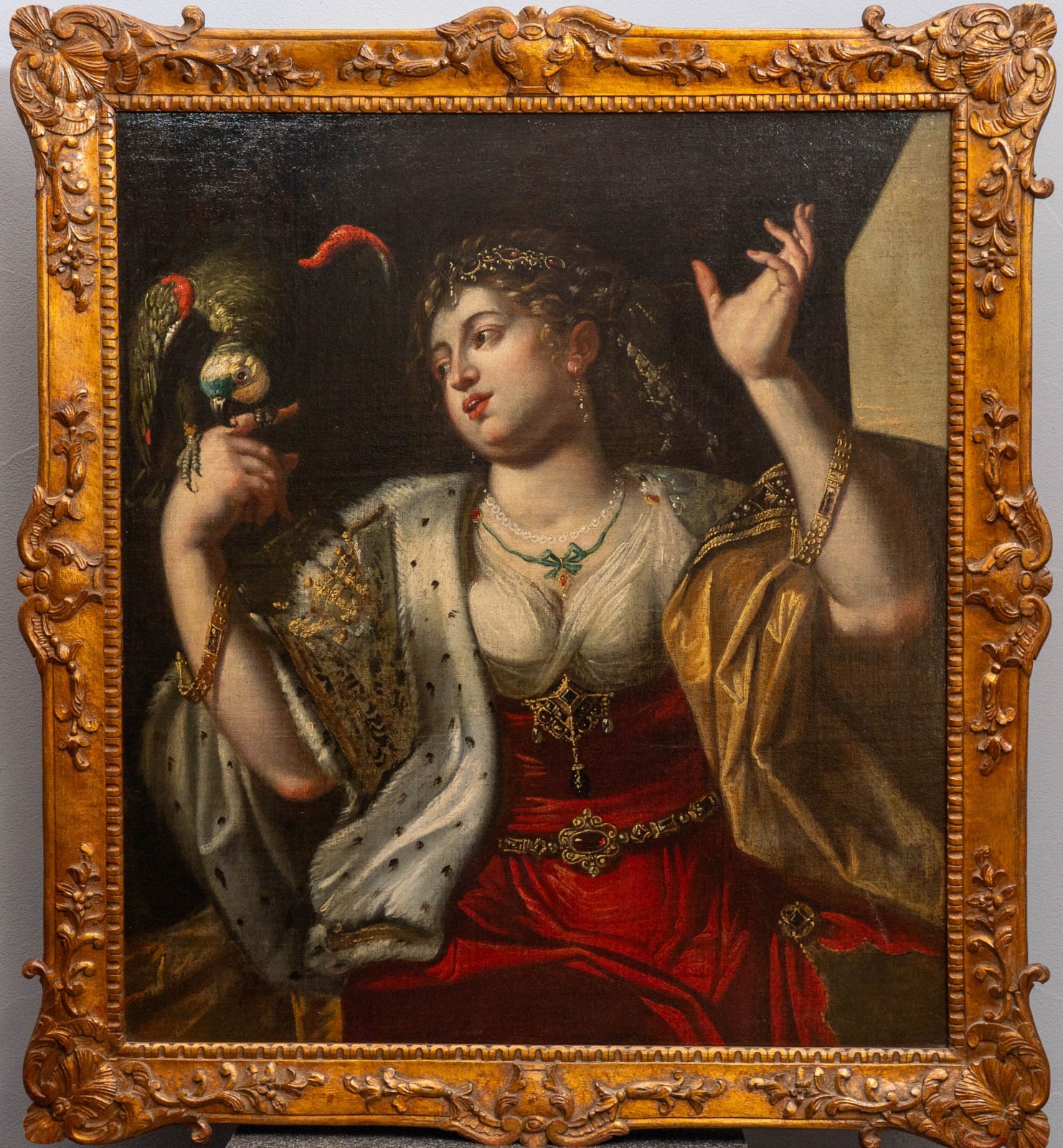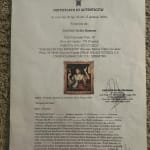Abraham Janssens The Younger
The painting: 80 x 91 cm., within a gilt carved wood frame measuring 96 x 107 cm.
This highly sensuous painting by the Flemish master Abraham Janssens the Younger (b. 1616 d. after 1649), perfectly encapsulates a pictorial allegory of touch. At centre stage is a voluptuous young woman, at the prime of her life, richly attired in a sumptuous long flowing red dress that has a diaphanous silk bodice that seemingly hides her modesty. Just below her breasts is an ornate jewelled clasp above a gold belt, inset with rubies and other precious stones. She also wears a lavish jewelled headdress, offset by glittering bracelets and necklaces. The feeling of opulence is also expressed by her ermine and embroidered silk-lined stole. Whilst the primary focus is the beautiful young woman, the main subject of the painting is an allegory of touch, as symbolised by the green feathered parrot who the young woman turns toward at the point at which it pecks at her outstretched index finger. Its beak manages to draw a drop of blood, its colour echoed in the red of her dress, by her pink pursed lips and on the red tips of the parrot’s wings. As an allegory alluding to touch, one of the five senses, represented here by an exotic bird pecking at the finger of a beautiful young woman, this was a popular subject amongst Flemish Renaissance painters, as also portrayed by Otto van Veen (1556-1626), Jacob de Backer (1560-90/91) and others.
Abraham Janssens II was born in Antwerp and baptised that year in the city’s cathedral. He was born into a great dynasty of painters. His mother was Sara Goetkint (c1573-c.1644) was the daughter of the artist and art dealer Peter Goetkint the Elder (c1540-83), who taught Jan Brueghel the Elder (1568-1625). Abraham Janssens II’s father was Abraham van Nuyssen Janssens (1575-1632), a renowned painter, best known for his historical, religious and mythological subjects. Janssens the Elder was also a contemporary and formidable rival to Peter Paul Rubens (1577-1640), whose influence can be seen in this present work as well as in many other works by Abraham Janssens the Younger. The latter had about seven siblings including Maria Anna (1609-68), who also became a painter, specialising in still-lifes, and married the artist Jan Brueghel the Younger (1601-78).
Having been trained by his father, Janssens II took over the elder’s workshop upon the latter’s death in 1632 and while continuing to paint he also worked as an art dealer. In 1636, he followed his father’s footsteps in becoming a master of the famous Antwerp Guild of St. Luke. That same year his daughter Marie Janssens was born and then three years later he, like many other Flemish artists, moved to Rome, where he studied classical antiquities and the work of the great Renaissance masters, especially Michelangelo. While in Rome, he shared lodgings for a while with his friend, the Dutch landscape painter Johannes Lingelbach (1622-74). Although it is not known when exactly Janssens the Younger died, we know that he was still in Rome in 1649 and most probably remained there for the rest of his life.
The present work dates to the 1630s, before Janssens moved to Rome, comparing with a number of other highly evocative works from that period, during which he executed a number of allegorical works including others that represented the senses, while some portrayed the Four Seasons. As here, the monumentality of the figure, the rich colour palette and elegant brushstroke reflect his understanding of Rubens’ style and typify characteristics of the most sumptuous Flemish painting of the seventeenth century. In addition to its virtuosity, this painting remains in an excellent untouched condition. It is also accompanied by a certificate of authenticity by the Galleria Romano Ischia, Riva del Garda, Italy.



